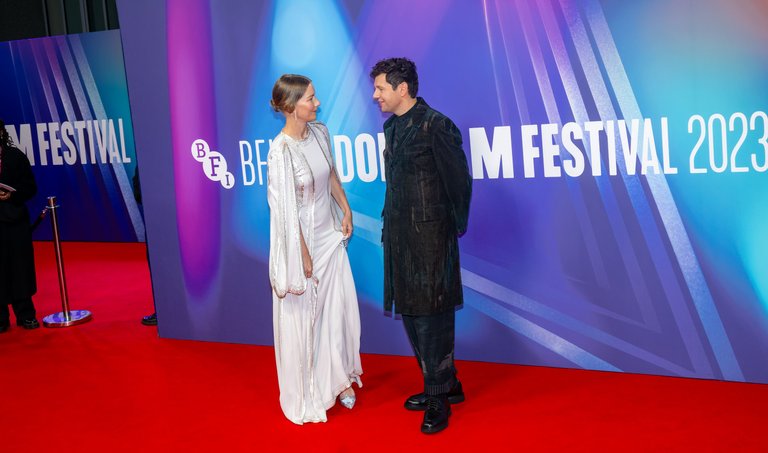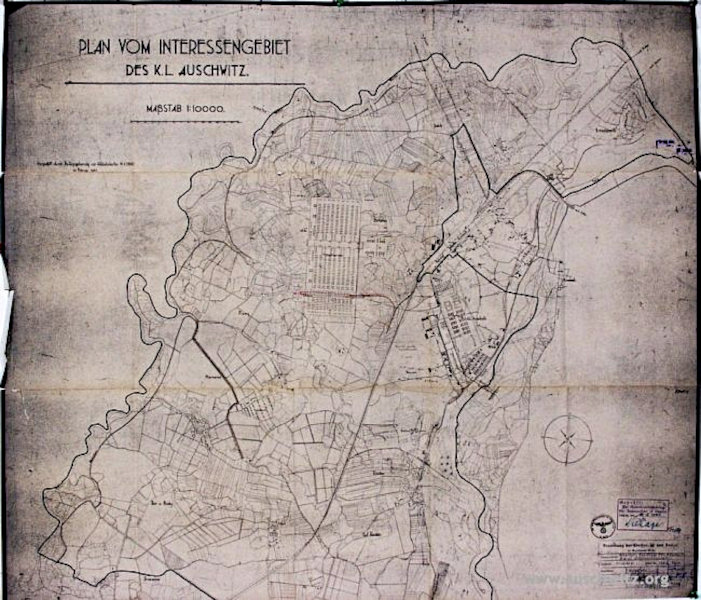Sandra Hüller and Christian Friedel, Stars of the Film

Credit: Raph_PH. Source: ZoneIntrestBFILFF121023.CC-BY-2.0. Picture was taken at BFI LFF Gala Premier Royal Festival Hall
On September 1, 1939 German troops invaded Poland. This, the final in a series of territorial incursions, prompted France and the UK to declare war on Germany. WWII had officially begun. The declaration of war, however, did not spare the Polish people. Poland was divided between Germany and the Soviet Union. Everyone in Poland who lived west of the Bug River was now under German rule.
Auschwitz1, Oświęcim, Poland

Image credit: BrckoGOS, Wikimedia Commons. Used under CC Attribution Share-Alike 4.0 International license. Auschwitz1 was built on the site of an army barracks and was converted to a prison-of-war camp in 1940.
One week before the invasion, on August 22, 1939, Adolf Hitler had given a speech at Obersalzberg, Germany in which he defined his plan for the people of Poland. He was going to send his 'death-head formations' to Poland, "with orders to them to send to death mercilessly and without compassion, men, women, and children of Polish derivation and language" . Thus the rationale, for Auschwitz concentration camp was established. Hitler added in that speech, "Poland will be depopulated and settled with Germans". The way forward for the people of Poland was clear.
It is the Auschwitz camp, and more specifically its perimeter, the Interessengebiet, which are the setting for Jonathan Glazer's movie, The Zone of Interest.
Map of the Zone of Interest, Drawn by the SS, 1941

Credit: SS(!!!). Source:http://auschwitz.org/en/gallery/historical-pictures-and-documents/archive-documents,2.html. Public domain. The caption associated with this image (on Wikimedia Commons) reads: "The map of the "KL Auschwitz interest zone" from February 1941. There is also a design of the so-called Schutzhaftlagererweiterung, camp in Birkenau and (marked in red) the side-track of the camp running from the train station in Oświęcim".
The Interessengebiet, or Zone of Interest, in English, was a 40 square kilometer buffer zone established between the camp and the surrounding area. In this zone lived the camp commandant, Rudolf Höss, and other personnel, including members of the SS, who controlled the camp.
Höss had joined the SS and had been part of its 'death-head units' since 1934. Death-head squad recruits were 'elite' members of the Nazi party. They were assigned to run concentration camps. Höss' first assignment was at Dachau in Bavaria.
Auschwitz was originally designed to confine Polish prisoners. The first prisoners at the camp were Polish. In order to make room for the camp and the perimeter, the local Polish population was expelled and many of their homes and businesses destroyed.
The opening scenes of Glazer's movie are idyllic. A family, with friends, is seen relaxing by a swiftly flowing river in lush countryside. The sun is shining. People are wearing swimming gear. A baby is coddled.
This is Rudolf Höss' family. The camera lingers on him as he looks across the river, hands on his hips, as though he is commanding the river. The sense is of complete peace.
Soon though we are brought to the home where this family lives. It is, as Höss' wife declares in one scene, their dream house. A dream lived in the shadow of a death camp.
In this clip Mrs. Höss is showing her visiting mother the garden. The mother asks about the camp wall, visible to the woman. Her daughter explains that they planted vines in front of the wall (to make it look better)
Throughout the film we see the Höss family's beautiful garden, and in the background the guard tower that looms over Auschwitz. There is almost never a scene in this idyllic setting where the camp is out of frame. If we don't see a guard tower, we hear guns shots, and screams. We hear dogs barking, obviously guard dogs. We see prisoners working in the garden.
In one scene the children are bathing in the river with their father, the commandant. Suddenly, debris floats by and Höss realizes he is holding human remains. The family flees from the river and the next scenes show the children being scrubbed thoroughly.
While a wall divides the camp from the Höss home, there is no true division between the horrors on one side of the wall and the grotesque people on the other side.
I read one review of this film in which the author complained that not enough of the Auschwitz horror was shown. I don't think the purpose of this film is to show graphic scenes of inhumanity in the camp. I think the purpose is to show us how such inhumanity can happen.
Auschwitz Liberation, 1945, by the Soviet Army

Credit: Author unknown. Still shot from a film. Public domain. The well-known phrase over the gate to Auschwitz: Arbeit Macht Frei had practical significance. The camps were founded as work camps. Labor from the camp was used not only to construct the camp itself, but also to provide labor to nearby industries. These included chemical industry giant, IGFarben. In 1941 the director of IG Farben wrote to his colleagues that "Our new friendship with the SS is very fruitful."
Who did those things? What kind of person, of what mentality, of what worldview were they possessed that would would enable them to perpetrate such horrors?
We meet those people in this film. I think the most grotesque of all (in the film) is not Rudolf Höss, but his wife. It is she who threatens a maid by saying she can have her husband spread the girl's ashes over a field. It is the wife who takes from a prisoner a sack that has loot stolen from those who are imprisoned, likely gassed.
This woman pulls a fur coat from the sack. She tries it on, finds a lipstick in the pocket and puts that aside on her dresser. As she prances before a mirror to see if the coat suits her, she checks the hem. This a reminder that those who were imprisoned by the Nazis often hid valuables in the hems of their clothing. Höss was hoping to find a ring, a necklace, maybe a bit of gold.
It is Mrs. Höss who echoes Hitler's words. When her husband tells her he has been transferred and the family will have to leave the dream house, she refuses. She explains that they are living out the Führer's plan to have Lebensraum--living space--for Germans.
While Auschwitz and other concentration camps were intended to supply slave labor to industries, Auschwitz in particular eventually became more of an extermination camp.
In the first frame of the film clip shown here, fire from a crematorium chimney is visible:
In 1942 Auschwitz 2-Birkenau was constructed specifically to be an extermination camp. Höss oversaw construction of crematoria and gas chambers in order to facilitate completion of the Nazi goal of eliminating all Jews from Europe.
Toward the end of the war (this is covered in the film) Rudolf Höss is put in charge of handling a transport of Hungarian Jews. In the picture below is the rather horrifying image of smoke rising over the distant buildings.
Hungarian Jews Going through 'Selection' Process at AuschwitzII-Birkenau, 1944

Credit: Yad Vashem (photo likely taken by an SS officer). Public domain. Prisoners selected were either gassed or sent to work.
It might be said the Rudolf Höss is a monster, or monstrous, for carrying out ruthlessly the plan to exterminate millions. But he was a functionary, a tool, an expression of an ideology. Mrs. Höss was by far (in my opinion) more monstrous. She was an intrinsic part of the monstrous plan, but she did so for trinkets, for a lifestyle.
She wanted her house, her flowers her swimming pool. She wanted the servants and the prestige of her husband's position. It mattered not that the smoke from the crematoriums would rise up over the fence, that barbed wire ringed her property. She was not blind to it. She embraced these tools that enabled her to have 'gardeners', free labor sent from the camp to do her bidding. It is apparent in the film that she didn't have to lift a finger.
I watched this movie twice. Each time I was perplexed more by Rudolf Höss than by his wife. She was not a cipher. She was devoid of morality. He, on the other hand, seemed to be more complex. The last scene of the movie suggests this, when he is shutting off the lights to a building, going down flights of stairs, and stops to wretch several times.
In this clip, the scene where Rudolf Höss wretches alternates with a modern day scenes of workers cleaning the Auschwitz-Birkenau Memorial and Museum.
The Zone of Interest is a brilliant film. I had never heard of it before I chanced upon it when I was channel surfing. The film won many awards, among them an Oscar for Best International Feature film.
There is much that is remarkable about this film, but the sound deserves special mention. Hard to describe, it sort of tells the story on its own and fittingly won several prizes from different organizations. Also, the visual effects are startlingly effective: a black screen, like a void; a blood-red flower that fills the screen and lingers.
The acting is appropriately low key. The story is about mundane lives lived in unbelievably extraordinary circumstances.
The movie can be viewed on a number of streaming services, including Amazon Prime, Hulu and Max. I saw it on Max.
Film Facts
- Producers(From Wikipedia)
James Wilson
Ewa Puszczyńska - Run time (From Wikipedia)
102 Minutes
(Information below derived from IMDB) - Director Jonathan Glazer
- Writer Jonathan Glazer Martin Amis (Amis wrote the book upon which the film is loosely based)
- Main Actors
Sandra Hüller as Hedvig Höss
Christian Friedel as Rudolf Höss